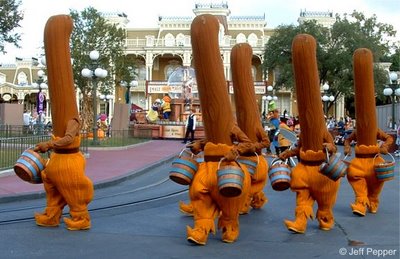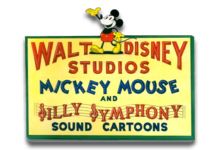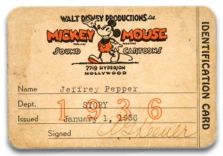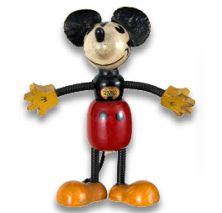 The 21st century begins October 1, 1982.
The 21st century begins October 1, 1982.I remember getting goose bumps the first time I read those words during the summer of 1982. Even then, before the park had opened, you could sense from that one short sentence the awe-inspiring effect this place would have.
During its first decade of operation, it was almost impossible not to get caught up in EPCOT’s forward thinking idealism. But ironically, the closer the 21st century approached, the more it seemed that EPCOT drifted from its original theme and mission. Now, some six years after the arrival of the new millennium, Epcot has become a shadow of its original conception.
I recently discovered the blog EPCOT Central that very directly addresses Epcot’s changes over the past two decades. The commentary it offers is insightful and very well articulated, despite the author’s own self-acknowledged cynical and sometimes bitter tone. And he very directly lays the blame for what he sees as the park’s decline on the Disney Company and its Imagineers. And I can’t say that I entirely disagree.
But I personally think that it goes even beyond the company’s efforts, or lack thereof. It’s not so much that Epcot no longer lives up to its original ideals, or that the Disney Company has let the park drift away from the themes of international community and a dynamic, hopeful future.
No, the very sad truth is this: The world hasn’t lived up to EPCOT.
Consider the original EPCOT attractions that truly epitomized the theme of a bright, positive future filled with countless challenges and innovations. Horizons, The Living Seas, Communicore and to some extent Spaceship Earth. As time went on and it became apparent that these optimistic visions would be likely unrealized, these attractions soon lost the very heart of what made them so appealing in the first place. Unlike the Magic Kingdom or Disney-MGM Studios that remove you completely from the outside world, EPCOT has to, in many ways, embrace and celebrate the real world. In observing the last twenty five years of this planet’s history, that has indeed become an increasingly difficult set of objectives.
A microcosm of this overall premise can be seen in the company’s development of the Space pavilion that ultimately resulted in Mission: Space. Initial plans were fairly extensive and ambitious, and NASA was always mentioned as a creative partner in the endeavor. Then in January of 1986, the unthinkable happened when Challenger exploded shortly after liftoff. The next twenty years would not be kind to NASA and the United States space program.
In the wake of this, consider that you’re an Imagineer looking for inspiration in creating new ideas for a space attraction--where do you draw such inspiration? From a space program that has seen two shuttle disasters, a troubled space telescope, and an International Space Station long in development but incredibly slow in realization. NASA, once a shining symbol of American spirit and ingenuity, had become a sad reminder of tragedies and failed dreams. It is no wonder that when a space attraction was finally realized, it was a very much diminished version of what was originally conceived and planned.
The space pavilion was not the only EPCOT entity impacted by the sometimes harsh realities of the outside world. A pallor was cast over the Universe of Energy in the spring of 1989 when its sponsor Exxon became mired in the negative publicity associated with Exxon Valdez oil spill in Alaska. A much lighter, almost comical approach was taken in 1996 when it evolved into Ellen’s Energy Adventure, severely minimizing its original tone and forward-thinking feel.
I’ve often wondered if political realities had anything to do with a proposed Israel pavilion in World Showcase never coming to fruition. I know that when I personally experienced the Israel simulator-film attraction at the Millennium Village in 2000, I was only reminded of the conflicts and bloodshed in the lands being showcased before me.
Throughout the 1990s, and especially over the last five years since 9/11, the world has changed dramatically from the one into which EPCOT Center was born. Even if Disney could find the wherewithal to bring Epcot back to its original guiding principles, the question remains--would the general public be receptive?
The past ten years, characterized by terrorism, war, political and cultural polarization, genocides and calamitous natural disasters, seem to have pushed us further and further away from the positive ideals EPCOT Center embodied at its inception. As a society, it seems we are no longer inclined to embrace a positive, optimistic view of the future, even though we do not hesitate to enjoy and take advantage of the fruits of mankind’s inventiveness, resourcefulness and creativity. We very much cast a cynical eye to future vision clouded by rose-colored glasses. That “great big beautiful tomorrow” has become a clichéd anachronism that few take to heart and many scorn outright. I’m guessing that a lot of folks out there would prefer the fantasy of Nemo and Friends, to confronting the likely never-to-be realized dream of a Seabase Alpha. I have little doubt that there are probably Imagineers who would like nothing more than to return Epcot to glories past, but unfortunately perceive a public that prefers fantasy and thrills to education, enlightenment and innovation.



































































